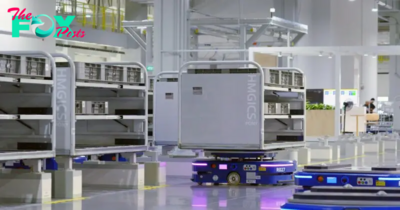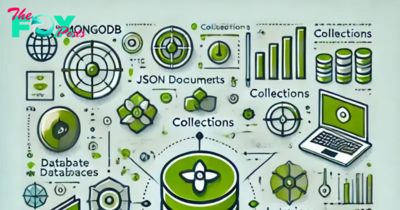Technology
Can Artificial Intelligence Help Knock Out America’s Inflation Problem? 5 Things To Know
Experts say the latest artificial intelligence technology, generative AI, will help reverse a prolonged slowdown in productivity growth that has kept costs high for businesses and made inflation harder to reign in.
It could also lead to lower wages for company workers.
Widespread use of generative AI could put productivity on steroids, and although it could be disruptive for workers and push down wages and salaries, it is expected to boost growth.
Productivity grew with other technological advances such as the adoption of electricity in the first half of the 20th century and the growth surge technological advances in late 1990s dot.com boom.
Generative AI refers to models or algorithms that create brand-new output, such as text, photos, videos, code, data, or 3D renderings, from the vast amounts of data they are trained on. The models “generate” new content by referring back to the data they have been trained on, making new predictions.
Could AI help fight America’s iNFLation problem?
BlackRock’s Larry Fink: AI can bring down inflation
AI has huge potential to increase productivity, according to Larry Fink, CEO of the world’s largest asset manager, BlackRock. “It may be the technology that can bring down inflation,” Fink said at the company’s Investor Day in June.
AI will affect nearly every sector and occupation, said the Organisation for Economic Cooperation and Development (OECD). OECD members are devoted to stimulating world trade.
Discover How Affordable Peace of Mind Can Be:
Get Your Life Insurance Quote Today!
Like the steam engine, which set off the industrial revolution, and electricity, which brought dramatic advances in communication and manufacturing, AI “can be used pervasively across many industries and to foster general productivity gains,” said the OECD.
Aging populations and the trend toward “deglobalization” or weaker trade and investment ties between countries have contributed to slower productivity growth — often measured in GDP – in many advanced economies since at least the 2008 global financial crisis, CNN reported.
Rising wages can cause inflation
The productivity problem is becoming more urgent as tight labor markets force wages to rise. “If wages rise by more than productivity, then… it costs more to make the same amount of output, and that can cause iNFLation,” said David McMillan, a professor in finance at the University of Stirling, Scotland, in a CNN interview.
Connversely, when a workforce is more productive it produces more goods and services at a price. “This means there is a greater supply of these things, which puts downward pressure on prices and is therefore associated with lower iNFLation,” McMillan wrote in The Conversation.
Pay raises of 5-to-7 percent in the U.S. and Europe now far outstrip annual average productivity growth, which has been at or below 1.5 percent since the mid-2000s, according to official statistics. The only way to raise productivity is to increase the volume of goods and services an economy can produce.
US productivity expected to double in 10 years or less
AI could have a greater impact on productivity than earlier technologies “because it seeks to address intelligence, which is a very fundamental input for production,” said Erik Brynjolfsson, director of the digital economy lab at Stanford University.
Brynjolfsson and other economic researchers wrote in a paper that they anticipate U.S. productivity doubling over the next decade thanks to AI — a rate last seen in the 1990s and early 2000s when the U.S. saw a computer-powered productivity boom.
It could happen sooner because most generative AI tools live on the internet — “the technology we already have on our desks” — making them widely accessible, Brynjolfsson said.
AI is also user-friendly because all it asks of the user is the ability to speak and write.
“For both those reasons, I anticipate this AI revolution is going to be much more compressed” than earlier tech breakthroughs, which took decades to transform economies, Brynjolfsson said. “Instead of decades it’s going to be years and in some cases months.”
AI could drive down salaries
Goldman Sachs analysts estimate that 18 percent of jobs around the world could be automated, with AI-powered computers making 7 percent of the U.S. workforce redundant, especially white-collar workers.
The real promise – and threat – of AI is to slash the cost of labor-intensive services where comPetition has been limited, Reuters reported.
AI has a clear potential to be a deflationary force, especially in economies like the U.S. where services play a big role. For example U.S. medical services account for about 6 percent of the U.S. consumer price index. A 20 percent drop in the cost of healthcare would reduce headline inflation by around 1.2 percent.
AI could drive down salaries of law clerks, web developers, call center operators and advertising copywriters.
AI is ‘wildly deflationary,’ out-of-work people could need government help
From an economic perspective, AI and all its associated tools are wildly deflationary, wrote Ron Insana, a CNBC analyst and senior advisor at London asset management company Schroders.
AI is being adopted fast by businesses and may reduce the need for 300 million jobs globally, according to Goldman Sachs estimates. As with every technological advancement, workers will be displaced and costs decline.
“Inflation could fall quickly and sharply as these new tools are rolled out,” Insana said.
Post-pandemic iNFLation remains elevated but is down from its peak rate in what Insana described as a return to nomalization.
One of the downsides of lower inflation is “an idle workforce,” he said. “New means of support, like a universal basic income, might be required to assist those thrown off the job. That, too, would be deflationary as government compensation would not likely rise to the level of current wages.”
Image: Message from artificial intelligence by Michael Cordedda, https://www.flickr.com/photos/mikeycordedda/ https://creativecommons.org/licenses/by/2.0/
-

 Technology14h ago
Technology14h agoBreaking up Google? What a Chrome sell-off could mean for the digital world | The Express Tribune
-

 Technology1d ago
Technology1d agoAI harm is often behind the scenes and builds over time – a legal scholar explains how the law can adapt to respond
-

 Technology1d ago
Technology1d agoNewborn planet found orbiting young star, defying planet formation timeline | The Express Tribune
-

 Technology1d ago
Technology1d agoAwkwardness can hit in any social situation – here are a philosopher’s 5 strategies to navigate it with grace
-

 Technology1d ago
Technology1d agoNo need to overload your cranberry sauce with sugar this holiday season − a food scientist explains how to cook with fewer added sweeteners
-

 Technology1d ago
Technology1d agoTeslas are deadliest road vehicles despite safety features: study | The Express Tribune
-

 Technology2d ago
Technology2d agoThere Is a Solution to AI’s Existential Risk Problem
-

 Technology2d ago
Technology2d agoUS pushes to break up Google, calls for Chrome sell-off in major antitrust move | The Express Tribune



























